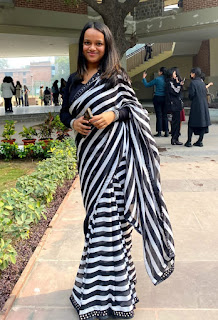 |
| By Sneha Dey |
In
2021 anti-gender equality activists conducted a targeted campaign against Hanna
Paranta– a well-known Somali women’s rights activist who uses her Facebook page
to support survivors of domestic violence and rape in the Somali diaspora. She
was restricted from posting by Facebook as her content had been repeatedly
mis-flagged as inappropriate. Without an active Facebook account and that blue
badge which marked her status as a verified public figure, her digital work to
raise awareness on gender discrimination was shut down.”
In
our digital age, social media has become an integral part of our daily lives.
But beneath its seemingly inclusive façade lies a persistent issue: gender
disparity. Despite its potential to connect individuals and amplify voices,
social media platforms often fall victim to perpetuating gender-based bias and
discrimination. Social media often acts as a mirror, reflecting the gender
biases and discrimination present in the society. Stereotypes regarding gender
roles, appearance, and behaviour are amplified through posts, photos, and
comments on various platforms. Women are frequently objectified, judged, and
subjected to unrealistic beauty standards, while men are often pressured to
conform to masculine norms. This contributes to the reinforcement of harmful
gender stereotypes and the perpetuation of inequality.
One
significant aspect of gender disparity on social media is the gender pay gap. The
gender pay gap is a global issue, with women in the world’s leading economies
earning only 86.2% of what men earned in 2021. This gap is prevalent even in
the field of social media influencing where women earn only 76% of the income
of their male peers. This discrepancy is particularly unsettling because this
industry is predominantly made up of women. There have been a few different
studies that open our eyes to income inequality between male and female
influencers. Influencer analytics platform HypeAuditor was one of the first
companies to bring this issue to light with a study they published in
early 2020. They conducted a survey of over 1,600 influencers to gather
information about average rates across various areas, promo formats, and more.
Another survey
conducted in 2022 by influencer marketing software IZEA saw similar
results. Their findings showed us that across all social media platforms, men
make 30% more than women, charging $2,978 per post compared to $2,289. While
this gap has dropped since 2019, it increased from 2020 and has existed for the
last seven years.
Influencer
CRM Klear also did their own research back in 2019 and 2020 to discover
discrepancies in influencer pricing and were shocked to find that there was
such a large pay gap between male and female influencers.
They
discovered an average $128 difference between the two’s rates, an increase
of $20 per post from 2019 to 2020.
For
sponsored content and promotions including multiple content types, we see the
biggest gender pay gap of them all. Men are earning nearly 50% more than women,
charging an average of $3,051 to women’s $2,040 for an Instagram post and
story, and charging an average of $4,042 to women’s $2,704 for an Instagram
post, story, and video. This gap not only reflects an economic
imbalance but also hinders women from fully participating and benefiting from
the opportunities provided by social media.
Furthermore,
gender disparities are evident in the representation and visibility of
individuals on social media. Women, especially marginalized groups (dalit
women, trans women etc.) may face additional barriers to participating in and
being heard on these platforms. Biases in algorithms and content moderation can
result in unequal visibility, limiting the reach of women’s voices and
perspectives. This visibility gap can further exacerbate the existing power
imbalances and hinder progress towards gender equality.
Social
media platforms have also become breeding grounds for online harassment and
cyberbullying, disproportionately affecting women. They face an increased risk
of receiving derogatory comments, threats, and sexual harassment. This toxic
environment can deter women from fully participating in online discussions,
expressing themselves, and exercising their rights to freedom of speech and
expression. Despite these challenges, social media has also become a powerful
tool for challenging and changing gender disparities. It has provided a
platform for women and marginalized communities to raise their voices, share
stories, and advocate for change. Hashtags such as #MeToo and #TimesUp have
sparked global movements and shed light on the pervasive issues of gender-based
violence and discrimination. Online campaigns and grassroots activism have
enabled collective action, fostering solidarity and driving societal change.
Moreover, social media has facilitated knowledge-sharing and access to
resources, empowering individuals to educate themselves and others about gender
disparities. It has allowed for the dissemination of information regarding
women’s rights, gender equality initiatives, and opportunities for advocacy. To
address gender disparity on social media, it is crucial for platform owners and
policymakers to enforce stricter regulations and adopt proactive measures.
Efforts should be made to increase diversity and inclusivity within social
media companies, ensuring equal representation and decision-making power. Algorithms
and content moderation processes must be revised to minimize bias and mitigate
the perpetuation of harmful stereotypes. Moreover, stronger measures should be
implemented to combat online harassment and hold perpetrators accountable,
creating safer online spaces for all users.
In
conclusion, social media presents a double-edged sword regarding gender
disparity. While it reflects and amplifies existing inequalities, it also
offers a platform for challenging and changing them. By recognizing and
addressing these disparities, fostering inclusivity, and promoting positive and
empowering narratives, social media can become a catalyst for progress towards
gender equality both online and offline.
References:
https://influencermarketinghub.com/male-female-influencer-income-inequality
www.aauw.org/resources/policy/pfa-toolkit/social-media/
https://eavi.eu/social-media-and-gender-a-tricky-combination
https://www.bbc.com/news/world-africa-58355603
Comments
Post a Comment